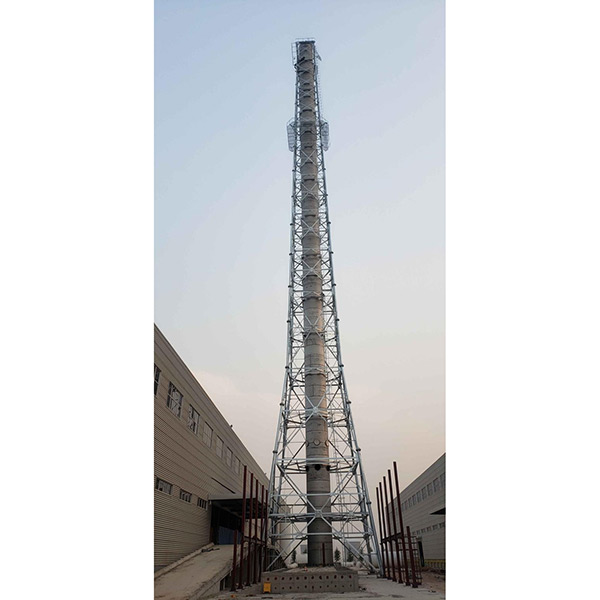Advances in Chemical Plant Pylon Steel Chimney Technology
2024-07-10
Introduction
The evolution of technology in industrial processes has significantly impacted the design and functionality of chemical plant pylon steel chimneys. These structures, essential for managing exhaust emissions, have seen numerous advancements that enhance their efficiency, durability, and environmental performance. In this blog, we will explore the latest technological developments in chemical plant pylon steel chimneys and their implications for the industry.
Innovations in Material Science
1. Advanced Steel Alloys
- Corrosion Resistance: New steel alloys offer enhanced resistance to corrosion, crucial for chimneys exposed to harsh chemicals and weather conditions.
- High-Temperature Stability: Improved alloys can withstand higher temperatures without compromising structural integrity, ensuring reliable performance in extreme conditions.
2. Composite Materials
- Lightweight and Strong: Composite materials are being used to reinforce steel chimneys, making them lighter yet stronger. This reduces the load on the foundation and enhances seismic performance.
- Extended Lifespan: The use of composites can significantly extend the lifespan of chimneys by reducing wear and tear from chemical exposure and temperature fluctuations.
Structural Enhancements
1. Modular Design
- Ease of Installation: Modular designs allow for easier transportation and assembly of chimneys, reducing installation time and costs.
- Scalability: Modular components can be added or replaced as needed, providing flexibility to accommodate changes in plant operations or emission requirements.
2. Seismic Resilience
- Advanced Engineering: Innovations in engineering have led to the development of chimneys that can better withstand seismic activity, ensuring safety and operational continuity in earthquake-prone areas.
- Dynamic Dampers: The integration of dynamic dampers helps absorb and dissipate seismic energy, reducing the stress on the chimney structure.
Emission Control Technologies
1. Integrated Scrubbing Systems
- Enhanced Filtration: Modern scrubbing systems are more effective at removing particulates and harmful gases from emissions, improving air quality and compliance with environmental regulations.
- Reduced Maintenance: Advanced scrubbing systems require less frequent maintenance, reducing downtime and operational costs.
2. Real-Time Monitoring and Control
- Automated Monitoring: State-of-the-art sensors and control systems provide real-time data on emission levels, enabling immediate adjustments to maintain compliance with environmental standards.
- Data Analytics: The use of data analytics helps predict emission trends and optimize chimney performance, ensuring efficient operation and proactive maintenance.
Environmental and Economic Benefits
1. Lower Emissions
- Cleaner Exhaust: Technological advancements in emission control have led to significant reductions in harmful emissions, contributing to better air quality and a lower environmental footprint.
- Compliance with Regulations: Enhanced emission control ensures compliance with stringent environmental regulations, avoiding legal penalties and fostering a positive corporate image.
2. Cost Efficiency
- Energy Savings: Improved materials and designs contribute to better thermal efficiency, reducing energy consumption and operational costs.
- Reduced Maintenance Costs: The durability and advanced monitoring capabilities of modern chimneys lower the frequency and cost of maintenance and repairs.
3. Sustainable Operations
- Resource Efficiency: The use of advanced materials and efficient designs reduces the overall resource consumption, promoting sustainable industrial practices.
- Corporate Responsibility: Adopting cutting-edge technology in chimney design demonstrates a commitment to environmental stewardship and corporate responsibility.
Case Studies
1. Successful Implementation in Chemical Plants
- Case Study 1: A chemical plant in Germany implemented a modular pylon steel chimney with advanced scrubbing systems, resulting in a 30% reduction in maintenance costs and a 40% improvement in emission control.
- Case Study 2: In Japan, a chemical plant adopted a seismic-resilient chimney design, ensuring uninterrupted operations and safety during a major earthquake, with no structural damage reported.
2. Industry Adoption Trends
- Global Adoption: Industries worldwide are increasingly adopting advanced chimney technologies to meet environmental standards and improve operational efficiency.
- Future Prospects: The trend towards more sustainable and technologically advanced chimneys is expected to continue, driven by regulatory pressures and the need for cost-effective solutions.
Conclusion
The technological advancements in chemical plant pylon steel chimneys have transformed their role in industrial operations. From improved materials and structural designs to advanced emission control systems, these innovations have enhanced the efficiency, durability, and environmental performance of chimneys. By embracing these advancements, chemical plants can achieve greater operational efficiency, regulatory compliance, and environmental sustainability, paving the way for a cleaner and more responsible industry.



